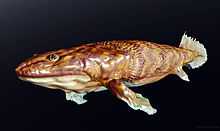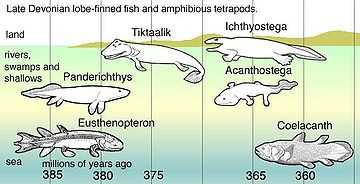Panderichthys
| Panderichthys Temporal range: 380Ma Late Devonian | |
|---|---|
 | |
| Reconstruction of Panderichthys rhombolepis | |
| Scientific classification | |
| Kingdom: | Animalia |
| Phylum: | Chordata |
| Class: | Sarcopterygii |
| Order: | Elpistostegalia |
| Family: | †Panderichthyidae Vorobyeva, 1968 |
| Genus: | †Panderichthys Gross, 1941 |
| Type species | |
| †Panderichthys rhombolepis Gross, 1941 | |
Panderichthys is a 90–130 cm long fish from the Devonian period 380 million years ago, (Frasnian epoch) of Latvia. It is named after the German-Baltic palaeontologist Christian Heinrich Pander. It has a large tetrapod-like head.
Panderichthys, which was recovered from Frasnian (early Late Devonian) deposits in Latvia, is represented by two species. Panderichthys stolbovi is known only from some snout fragments and an incomplete lower jaw. Panderichthys rhombolepis is known from several more complete specimens. Although it probably belongs to a sister group of the earliest tetrapods, Panderichthys exhibits a range of features transitional between tristichopterid lobe-fin fishes (e.g., Eusthenopteron) and early tetrapods.
Paleobiology

Recent reexamination[1] of existing Panderichthys fossils using a CT scanner shows four very clearly differentiated distal radial bones at the end of the fin skeletal structure. These finger-like bones do not show joints and they are quite short, but nonetheless show an intermediate form between fully fish-like fins and tetrapods.
In January 2010, Nature reported well-preserved and "securely dated" tetrapod tracks from Polish marine tidal flat sediments approximately 397 million years old.[2] Therefore, Panderichthys can only be a "late-surviving relic",[3] showing traits that evolved during the transition from fish-like creatures to tetrapods, but whose date does not reflect that transition. The tracks "force a radical reassessment of the timing, ecology and environmental setting of the fish–tetrapod transition, as well as the completeness of the body fossil record."[2]
See also

- Panderichthys, suited to muddy shallows;
- Tiktaalik with limb-like fins that could take it onto land;
- Early tetrapods in weed-filled swamps, such as:
- Acanthostega which had feet with eight digits,
- Ichthyostega with limbs.
References
- ↑ http://www.news.com.au/dailytelegraph/story/0,22049,24381533-5016574,00.html
- ↑ 2.0 2.1 Niedzwiedzki, G., Szrek, P., Narkiewicz, K., Narkiewicz, M and Ahlberg, P., Nature 463(7227):43–48, 2010, Tetrapod trackways from the early Middle Devonian period of Poland, 7 January 2010.
- ↑ Editor's summary: Four feet in the past: trackways pre-date earliest body fossils. Nature 463.